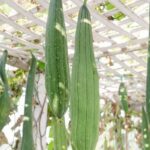Are you interested in starting a vegetable garden but have limited space to work with? In this article, we will explore the world of small-space vegetable gardening and how you can grow a variety of vegetables even in the smallest of areas. From container gardening to vertical gardening techniques, we will discuss different methods and plants that take up the least space while still producing a bountiful harvest.
When it comes to small-space vegetable gardening, choosing the right plants is essential. Whether you have a tiny balcony or a small backyard, there are plenty of options for growing vegetables in limited space. We will also delve into companion planting, a method that promotes efficient use of space by pairing compatible plants together.
Embracing the potential of small-space vegetable gardening allows you to enjoy fresh produce right at your doorstep while maximizing every inch of available space. With our tips and creative ideas, you’ll be well on your way to creating a thriving miniature vegetable garden that suits your space constraints. Let’s dive into the world of small-space vegetable gardening and discover the possibilities for growing your own nutrient-rich vegetables at home.
Benefits of Growing Vegetables in Small Spaces
One of the main advantages of growing vegetables in small spaces is the ability to maximize the use of available area, regardless of how limited it may be. With the right vegetable gardening plants that take least space, even a small balcony or patio can become a thriving garden. This is especially beneficial for urban dwellers or individuals with limited outdoor space.
Another benefit of small-space vegetable gardening is the convenience and accessibility it offers. By having a garden close to your home, you can easily tend to your plants, harvest fresh produce, and enjoy the rewards of your efforts without having to travel far. This makes it easier to incorporate fresh, homegrown vegetables into your daily meals, promoting a healthier lifestyle.
In addition, growing vegetables in small spaces can also be more manageable and less time-consuming compared to larger gardens. With fewer plants to care for, it becomes more feasible to give each one the attention they need. This can result in better plant health and productivity, leading to a more successful harvest overall. Moreover, smaller gardens often require less maintenance and resources such as water and fertilizer.
- Tomatoes (determinate varieties)
- Radishes
- Lettuce
- Spinach
- Chard
- Peas (bush varieties)
- Green onions
- Herbs (basil, parsley, cilantro)
Choosing the Right Vegetables for Limited Space
When it comes to small-space vegetable gardening, choosing the right vegetables is crucial for a successful and bountiful harvest. Limited space requires careful consideration of which plants will thrive in a confined area and produce a high yield. Here are some vegetables that take up the least space and are perfect for small-space gardening:
- Radishes: These fast-growing root vegetables are ideal for small gardens, as they can be sown close together and harvested within a few weeks.
- Spinach: This leafy green does not require much space and can be continuously harvested by picking outer leaves, making it perfect for small gardens or containers.
- Cherry Tomatoes: Compact and prolific, cherry tomato plants are well-suited for small spaces and can even be grown in hanging baskets or vertical planters.
In addition to these space-saving vegetables, other options include herbs like basil, parsley, and chives, as well as compact varieties of peppers, cucumbers, and squash. By carefully selecting the right vegetables for limited space, gardeners can maximize their yield without sacrificing variety.
Moreover, utilizing techniques such as succession planting and intercropping can further optimize the use of limited space in a vegetable garden. Succession planting involves planting new crops as soon as old ones are harvested, while intercropping involves planting different types of vegetables together to maximize space and encourage beneficial relationships between plants. By implementing these methods alongside choosing space-efficient vegetables, gardeners can make the most of their small gardening area.
Container Gardening
Choosing the Right Containers
When it comes to container gardening, selecting the appropriate containers is crucial for success. It is important to choose containers that are large enough to accommodate the root systems of the chosen vegetables. Additionally, ensuring that the containers have proper drainage is essential to prevent waterlogging and root rot.
Optimizing Vertical Space
One of the benefits of container gardening is the ability to utilize vertical space. By incorporating trellises, stakes or hanging planters into the setup, individuals can grow vine vegetables such as tomatoes, cucumbers, and peas without taking up valuable floor space. This technique not only maximizes space but also adds visual interest to the overall garden design.
Considerations for Soil and Watering
Since container gardens have limited soil volume compared to traditional gardens, it is important to use high-quality potting mix that provides proper nutrients and moisture retention for the plants. Additionally, regular watering is essential as containers tend to dry out more quickly than garden beds. To ensure successful growth, it is recommended to check soil moisture frequently and adjust watering accordingly.
By implementing container gardening techniques and choosing suitable plants for small spaces with limited soil access like vegetable gardening plants that take least space, individuals can enjoy freshly grown produce regardless of their living situation. With careful planning and maintenance, container gardens can yield bountiful harvests while making efficient use of available space.
Vertical Gardening Techniques for Small Spaces
When space is a limitation, gardeners need to get creative with their vegetable gardening. Vertical gardening is a technique that maximizes the use of vertical space to grow a variety of vegetables without taking up much ground space. This method involves training plants to grow upwards on trellises, fences, or other supports, making it an ideal option for small gardens, balconies, or patios.
Some popular vegetables that thrive in vertical gardens include cucumbers, tomatoes, pole beans, and peas. These vining plants can be trained to grow vertically using stakes, cages, or strings, allowing them to reach for the sun and freeing up valuable ground space for other crops. In addition to saving space, vertical gardening also helps improve air circulation around the plants and reduces the risk of pest infestations and disease.
For those looking to start a vertical garden, it’s important to choose the right support structures based on the specific needs of the vegetables being grown. Sturdy trellises are essential for supporting heavy fruits like pumpkins or melons, while lightweight netting may be sufficient for climbing peas or beans. Additionally, proper spacing between the plants is crucial to ensure they have enough room to grow and receive adequate sunlight and airflow.
| Vegetable | Recommended Support |
|---|---|
| Cucumbers | Trellis or A-frame structure |
| Tomatoes | Cage or stake system |
| Pole Beans | Fence or bamboo teepee |
| Peas | String or netting support |
Vertical gardening not only allows gardeners to cultivate a variety of vegetables in limited spaces but also adds visual interest to their outdoor areas. With the right approach and maintenance practices, small-scale vegetable gardens can yield bountiful harvests while making the most efficient use of available space.
Companion Planting for Efficient Use of Space
When it comes to small-space vegetable gardening, companion planting is a great strategy for making the most out of limited space. This technique involves planting different types of vegetables together that can benefit from one another’s proximity. For example, some plants can help repel pests that may attack others, while others can help improve the soil quality for their neighboring plants.
One popular combination in companion planting is planting carrots with onions and leeks. Carrots are known to benefit from the pungent smell of onions and leeks, which help to ward off pests that typically attack carrots.
Another example is planting basil near tomatoes, as basil is believed to enhance the flavor of tomatoes and discourage pests that often affect them. These are just a few examples of how companion planting can be an effective way to maximize space and promote healthy growth in a small vegetable garden.
In addition to pest control and flavor enhancement, companion planting also allows for efficient use of vertical space. By pairing climbing plants like beans or peas with taller non-vining plants like corn or sunflowers, you can make the most out of your garden’s vertical space, further optimizing your small vegetable garden layout.
| Companion Planting Combination | Benefit |
|---|---|
| Carrots with onions and leeks | Pest repellent |
| Basil near tomatoes | Flavor enhancement and pest repellent |
| Beans or peas with corn or sunflowers | Vertical space optimization |
Tips for Success in Small-Space Vegetable Gardening
When it comes to successful small-space vegetable gardening, there are a few key tips to keep in mind. First and foremost, it’s important to carefully plan out your garden layout to make the most of the limited space available. This includes choosing vegetables that take up minimal space while still providing a productive yield. Consider utilizing vertical gardening techniques and companion planting to maximize the use of every inch of your garden.
Another crucial aspect of small-space vegetable gardening is proper soil and container selection. Since space is limited, containers are often the best option for growing vegetables. Be sure to choose containers that are large enough for the specific vegetables you plan to grow, and use high-quality soil that will provide essential nutrients for healthy plant growth.
In addition, regular maintenance is key to success in small-space vegetable gardening. This includes diligent watering, pruning, and fertilizing as needed. By staying on top of these tasks, you can help ensure that your plants thrive in their compact growing environment.
Finally, don’t be afraid to get creative with your small-space vegetable garden. There are numerous innovative ideas for maximizing space, such as using hanging baskets, vertical trellises, or even repurposing items for container gardens. Embracing creativity and thinking outside the box can result in a bountiful harvest from even the smallest of spaces.
Creative Ideas for Small-Space Vegetable Gardens
When it comes to small-space vegetable gardening, creativity is key in making the most out of limited space. Here are some creative ideas to maximize the potential of your small-space vegetable garden:
Utilize Vertical Space
One of the most effective ways to make the most out of a small space is by utilizing vertical space. Consider installing trellises and vertical planters to grow vining vegetables such as tomatoes, cucumbers, and beans. This not only saves space but also adds visual interest to your garden.
Stackable Planters
Stackable planters are a great solution for those with limited ground space. These tiered containers allow you to grow multiple plants in a compact footprint. You can grow a variety of herbs, leafy greens, and even small root vegetables in these stackable planters.
Hanging Gardens
Hanging gardens are another creative way to maximize space in a small vegetable garden. Install hanging baskets or planters from fences, walls, or even overhead structures to grow strawberries, lettuce, or herbs. This not only adds more growing space but also adds an aesthetic appeal to your garden.
By thinking outside the box and implementing these creative ideas, you can turn even the smallest outdoor or indoor spaces into productive vegetable gardens. With the right planning and execution, you can enjoy a bountiful harvest from your small-space vegetable garden while adding greenery and freshness to your surroundings.
Conclusion
In conclusion, small-space vegetable gardening offers numerous opportunities for individuals with limited outdoor space to still enjoy the benefits of growing their own produce. By embracing creative techniques such as container gardening, vertical gardening, and companion planting, it is possible to maximize the use of small spaces and cultivate a thriving vegetable garden.
One of the key takeaways from this discussion is the importance of choosing the right vegetables for limited space. By selecting compact varieties, dwarf plants, and vegetables that can be trained to grow vertically, gardeners can make the most of their available space. Additionally, incorporating companion planting not only optimizes space but also promotes natural pest control and improves soil quality.
Furthermore, with careful planning and strategic placement of containers or raised beds, even those with tiny outdoor areas or balconies can grow a variety of vegetables. The potential of small-space vegetable gardening is vast, and with some creativity and ingenuity, anyone can enjoy a bountiful harvest regardless of their spatial constraints. Overall, this article has highlighted that with the right approach and a bit of resourcefulness, anyone can successfully cultivate a fruitful vegetable garden in minimal space.
Frequently Asked Questions
What Vegetables Take the Least Amount of Space to Grow?
Some of the vegetables that take the least amount of space to grow include lettuce, radishes, and microgreens. These plants can be grown in small containers or even in a vertical garden, making them ideal for limited space.
What Vegetables Don’t Need Lots of Space?
Vegetables that don’t need lots of space to grow are spinach, green onions, and herbs like basil and cilantro. These plants can thrive in smaller containers or in narrow plots, making them perfect for urban gardening or small yards.
How Do You Grow Vegetables in Limited Space?
To grow vegetables in limited space, you can use techniques such as vertical gardening, container gardening, and companion planting. Choosing compact or dwarf varieties of vegetables can also help maximize space. Additionally, using trellises and hanging baskets can make the most of limited areas while still allowing for a bountiful harvest.

If you’re looking to get into vegetable gardening, or are just looking for some tips on how to make your current garden better, then you’ve come to the right place! My name is Ethel and I have been gardening for years. In this blog, I’m going to share with you some of my best tips on how to create a successful vegetable garden.





